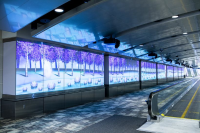 As Minnesota celebrated Indigenous Peoples' Day on Oct. 11, Arts@MSP was pleased to highlight the addition of an all-digital art gallery at MSP Airport (MSP) featuring the popular Minnesota Ojibwe Artist Jonathan Thunder and his Manifest'o exhibit.
As Minnesota celebrated Indigenous Peoples' Day on Oct. 11, Arts@MSP was pleased to highlight the addition of an all-digital art gallery at MSP Airport (MSP) featuring the popular Minnesota Ojibwe Artist Jonathan Thunder and his Manifest'o exhibit.
The exhibit will be on long-term display in the digital gallery located in the tunnel connecting Concourses A and B.
The Manifest'o exhibit features a colorful scene through animated vignettes that reflect Ojibwe narratives of water, land and sky. "Today, Ojibwe people of this region perceive the landscape with these stories in mind. It is through this lens that you are invited to see and hear," Thunder said.
Thunder, an enrolled member of the Minnesota's Red Lake Band of Ojibwe, was raised in the Twin Cities. He shares these contemporary adaptations of stories heard during his travels in northern parts of the state, where seven Ojibwe reservations are located.
"This exhibit represents so much of what the Arts@MSP program strives to achieve, which includes partnering with local artists whose work helps travelers experience the region's culture, environment and history," said Ben Owen, director of Arts@MSP.
Background and transformation
Some MSP Airport employees may remember when this tunnel was built about 20 years ago. For years the space had been lit with changing, colored bulbs meant to bring light and visual interest to an otherwise dark space. Then, several years back, the lighting system went offline, and all the lights were set to white while the MAC waited for backordered parts to fix it.
Enter Jonathan Thunder in 2019, who was encouraged by the Duluth Art Institute to submit a proposal – through the Arts@MSP open proposal process – to display his Manifest'o exhibit at MSP Airport. Manifest'o had already been on display at the University of Minnesota's Tweed Art Museum in Duluth, which commissioned the work.
There was only one problem. The airport did not have an arts location for displaying large digital artwork.
Owen says he was intrigued by the proposal and invited Thunder for a tour of the airport already having in mind the B Concourse tunnel space. After touring the terminal with Sam Fuentes, the Arts@MSP exhibition coordinator, both he and Thunder agreed it was the obvious choice.
But the space was still not set up for digital artwork.
Enter Martin Dean with Duluth AV Logistics, who helped bring Manifest'o to life at the Tweed. After touring the space, Dean provided specifications for what he believed would be necessary to transform the space to a digital gallery: 8 projectors that could throw between 6 and 7 thousand lumens – the brightness necessary for that space – and projection film applied to the glass cases.
Enthusiastic support
After obtaining enthusiastic support from the MSP Arts and Culture Steering Committee for both the artwork and the plans for the space, Owen worked with Alan Howell, senior architect and a member of the Committee, to identify a funding source, obtain permission to transform the space into a digital art gallery and coordinate construction activities. (The work would have been completed in 2020 if not for the COVID-19 pandemic and the interruption to normal operations it caused.)
"This isn't the first time an airport endeavored to turn a tunnel into an art experience," said Howell. "I believe the steering committee wanted to create an experience for the guest on-par with [Chicago] O'Hare's or Atlanta's, and other international airports that have transformed tunnels into an art experience. Like those, the B tunnel gallery creates yet another arts destination for travelers with a little more time on their hands before, between or after their flight."
It was a relatively straightforward transformation. Nothing had to be removed or relocated. Projection film was applied to the 160-foot wide and 6-foot-high display cases and pipes were installed in the existing ceiling for the projectors. Once a "short throw" lens was added to the projectors (because they are very close to the exhibit) the space was ready for Thunder's work.
Meanwhile, Thunder was tweaking his digital files to fit the exhibit's exact dimensions, as the airport team prepared the audio component and had the didactics translated into Ojibwe for the exhibit. Surprisingly, to everyone involved, the artwork looked almost perfect the moment it was first projected. After just a few minor adjustments, the work was ready for public display.
Check it out the next time you are in the vicinity or when you just need to stretch your legs a bit. It is not to be missed.

 As Minnesota celebrated Indigenous Peoples' Day on Oct. 11,
As Minnesota celebrated Indigenous Peoples' Day on Oct. 11,